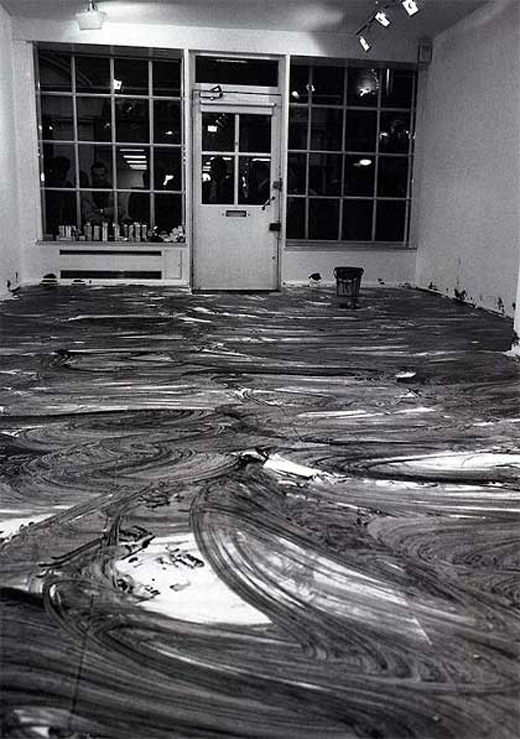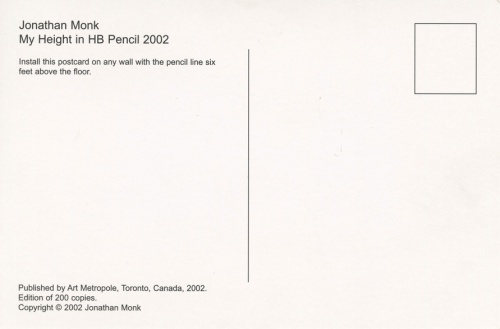Janine Antoni, Loving Care, 1992/2007

Loving Care
1993
Detail of performance, Anthony D’Offay Gallery, London
The artist soaked her hair in hair dye and mopped the floor with it.
Photo by Prudence Cuming Associates Limited
Courtesy the artist and Luhring Augustine
www.luhringaugustine.com


“In Loving Care, a much discussed work from 1992, using her hair as a mop, Antoni dipped her hair in dye and mopped the floor with it combining mopping, traditionally women’s work, with painting”.
Text: https://web.archive.org/web/20070411035729/http://www.massmoca.org/press_releases/09_2000/9_26_00.html
Photo: http://jessicaannkern.blogspot.ca/2011/03/artist-post-janine-antoni.html
Janine Antoni, Touch, 2002

“In Touch, which was commissioned for SITE Santa Fe in 2002, [Antoni] balances on a tightrope, a skill she has sought to master. Here, on the beach in front of her childhood home on Grand Bahama Island, the artist walks a line that is parallel to the horizon. Dressed in sky blue, she enters the landscape from outside the frame. When the wire dips under her weight, it appears to touch the horizon, creating the illusion that she is walking on the water. Like many of Antoni’s works, Touch records a relationship—a moment of contact—and reveals the artist’s longing to bridge the gaps between herself and viewers, between her work and art history”.
Photo/Text: http://www.artic.edu/aic/collections/artwork/184183
Trisha Brown, Untitled, 2007




“A dancer and choreographer associated with New York’s Judson Dance Theater from 1962 to 1964, Brown experiments with space, gravity, and the inversion of the body’s hierarchies. Interested in daily activities and the distribution of weight, she was an essential contributor to the invention of postmodern dance, a style that emerged from the movement experiments of the early 1960s. Earlier in her practice she made small, notational drawings to represent movement; now she makes large performative drawings using her whole body, merging movement and mark-making. This monumental drawing is related to Brown’s most recent choreography project, for an opera”.
Text: https://www.moma.org/collection/works/133311?locale=en
Photo: https://patternobserver.com/2010/12/03/whats-in-a-line/
Tony Orrico, Drawing Performance, 2010

“As much of a performance as it is a drawing, the work of American artist Tony Orrico explores the capacity of the human body as a physical tool for creating art. With a background in dance and choreography, Orrico utilizes his own body – sometimes just the wrist, sometimes his whole form – to generate massive drawings that are at once organic and highly precise”.
Text: https://www.designboom.com/art/tony-orrico-performance-drawings/
Photo: http://beautifuldecay.com/2015/01/19/tony-orricos-drawings-test-limits-physical-movement/
Tom Marioni, Walking Drawing, 2000

“Influenced by Eastern philosophy, Marioni also produced a series of action drawings in which gestural marks were the product of the artist running, jumping, or rotating his arm in a circular motion, using his body as a compass to record his farthest reach and marry physical effort with mark-making”.
Text: https://www.artsy.net/artwork/tom-marioni-walking-drawing-drypoint
Photo: https://crownpoint.com/artist/tom-marioni/
Meaghan Kombol, An attempt to draw a straight line on an NYC subway train, 2007


Photo: https://www.meaghankombol.com/
Ken Nicol, flogging a dead horse 9 from the series …and it’s ending one minute at a time, fall 2015




“Flogging a Dead Horse: The Seasons, […] is a mark-making action where Ken makes tally marks on a large sheet of paper with a pen until the ink begins to fade and eventually runs out entirely. The remainder of the work is finished with the inkless pen by scratching the tally marks into the page until the paper is filled. Each 100 hour work was completed within a single season and each is exhibited with the pen, or “dead horse”, that was used up in the creation of the work”.
Photo/Text: http://k-nicol.com/section/452386_and_it_39_s_ending_one_minute_at_a_time.html
Jonathan Monk, My Height in HB pencil, 2002


“The face of the edition, with a single pencil line. The card should be installed on any wall with the pencil line six feet above the floor”.
Text: https://artmetropole.com/events/launch-for-new-multiple-by-jonathan-monk-my-height-in-hb-pencil
Photo: https://artmetropole.com/archive/1221
Richard Long, A Snowball Track, 1964
“In 1964, when Long was eighteen years old and a student at the West of England College of Art in his hometown of Bristol, he went on a walk on the downs after a fresh fall of snow, making a snowball and rolling it along. When the snowball was too big to push any further, Long took a photograph of the track left by his trajectory. The action, ephemeral and recorded in a fairly artless image, was named Snowball Track (Bristol, 1964)”.
Text: http://londongrip.co.uk/2009/06/art-the-work-of-richard-long/
Photo: http://www.richardlong.org/Sculptures/2011sculpupgrades/snowball.html
Richard Long, A Line Made By Walking, 1967

“This formative piece was made on one of Long’s journeys to St Martin’s from his home in Bristol. Between hitchhiking lifts, he stopped in a field in Wiltshire where he walked backwards and forwards until the flattened turf caught the sunlight and became visible as a line. He photographed this work, and recorded his physical interventions within the landscape. Although this artwork underplays the artist’s corporeal presence, it anticipates a widespread interest in performative art practice. This piece demonstrates how Long had already found a visual language for his lifelong concerns with impermanence, motion and relativity”.
Text: http://www.tate.org.uk/art/artworks/long-a-line-made-by-walking-p07149
Photo: http://www.richardlong.org/Sculptures/2011sculptures/linewalking.html
Richard Long, Dusty boots line, 1988

Photo: http://www.richardlong.org/Sculptures/2011sculpupgrades/dusty.html
Richard Long, A Line in Ireland, 1974

Photo: http://www.richardlong.org/Sculptures/2011sculptures/lineireland.html
Richard Long, England, 1968

“In a field of daisies, Long picked flowers along two lines to form an ‘X’. The work existed only until the daisies grew again. He made a more permanent record in the form of this photograph. Long”s art develops through a physical involvement with landscape. During a walk, for instance, he may subtly rearrange natural elements at a particular spot as a way of marking his presence. ‘These works are of the place, they are a rearrangement of it and in time will be reabsorbed by it. I hope to make work for the land, not against it’, he says”.
Photo/Text: http://www.tate.org.uk/art/artworks/long-england-1968-p07151
Richard Long, Circle in Mist, 1986

Photo: http://www.richardlong.org/Sculptures/2011sculptures/circmist.html
Richard Long, Waterlines, 1989

“These words describe an event undertaken by the artist. They provide information which is specific but lacking in precise detail. Duration and distance covered, together with a generalised location, provide the parameters for the viewer’s imaginative interpretation. Water, invisibly marking the route taken by the artist, is the additional element connecting the starting and end points of the journey constituted by the shores of two seas”.
Text: http://www.tate.org.uk/art/artworks/long-waterlines-p11266
Photo: http://www.richardlong.org/Textworks/2011textworks/35.html
Pawel Althamer, Pfad (Path), 2007

“For sculpture projects münster 07, Pawel Althamer constructed a path. Starting where a footpath and bicycle trail meet in a municipal recreation area near Lake Aa, Althamer’s path will lead, through meadows and fields, out of the city. Just short of one kilometre, however, it will abruptly end in the middle of a field of barley. Surprised that the trail has suddenly ended, visitors will have to decide how to react upon this open situation and how to return to the city. Althamer’s idea for this project stems from his observation of how pedestrians and bicyclists here strictly obey the signs designating their respective paths, conforming to regulations in a way that appears unusually stringent to the average Polish observer”.
Text: https://www.skulptur-projekte.de/archiv/07/www.skulptur-projekte.de/kuenstler/althamer/index.html
Photo: http://www.shift.jp.org/en/archives/2008/02/skulptur_projekte_munster_07_6.html
Francis Alÿs, The Green Line, 2004

“In the summer of 1995 [Alÿs] performed a walk with a leaking can of blue paint in the city of São Paulo. The walk was then read as a poetic gesture of sorts. In June 2004, [he] re-enacted that same performance with a leaking can of green paint by tracing a line following the portion of the ‘Green Line’ that runs through the municipality of Jerusalem. 58 liters of green paint were used to trace 24 km. Shortly after, a filmed documentation of the walk was presented to a number of people whom [Alÿs] invited to react spontaneously to the action and the circumstances within which it was performed”.
Text: http://francisalys.com/the-green-line/
Photo: https://davidzwirnerbooks.com/product/francis-alys-sometimes-doing-something-poetic
Nina Katchadourian:
Paper map fragment in glass petri dish, 3/4 x 6 x 6 inches, 2000
Working with an atlas of Finland, I cut out the entire length of highway E75, which runs from Helsinki in the south to Utsjoki in the north. This long paper strip was coiled up and placed in a petri dish.
Cornelia Parker, Measuring Niagara With a Teaspoon, 1997

“The silver that makes up the piece of wire previously took the form of a Georgian teaspoon which, as the artist explained in a 2003 interview, has been melted and ‘drawn’ to the height of Niagara Falls’ […] To make this work, Parker took the teaspoon to a jeweller called Blundell’s in Wardour Street, London, where the silver object was melted down and then cast into an ingot […] The jeweller then turned the ingot into a piece of wire by pulling it through a series of progressively smaller holes in a device called a ‘draw plate’ until it was stretched to the desired length, a process that is termed ‘drawing’ “.
Photo/Text: http://www.tate.org.uk/art/artworks/parker-measuring-niagara-with-a-teaspoon-t07430
Tom Friedman, Untitled (Pencil shaving), 1992

“Friedman is concerned with the intimacies that working on a smaller scale can induce. Friedman also likes to keep the ideas behind the work small. For example, Friedman’s ‘Untitled,’ from 1992, (A pencil shaving that consists of the entire pencil), is not only a sculpture on a small scale, but also a small idea. The idea, (shave the pencil without it breaking), is beautiful in its own right […]”.
Text: http://students.smcm.edu/jspencerzavos/308/artresearch1.html
Photo: http://www.saatchigallery.com/aipe/tom_friedman.htm

“All the strands from a one-pound box of spaghetti, cooked, dried and connected end-to-end. The first piece connects to the last to form a continuous loop”
Photo/Text: http://www.luhringaugustine.com/artists/tom-friedman/artworks/sculptures-1990-1999?view=slider#9
Richard Tuttle, Ten Kinds of Memory and Memory Itself, 1973

“Tuttle’s subsequent series of works alternate between two and three dimensions in various ways. The 1973 string ‘drawings’ on the floor, entitled Ten Kinds of Memory and Memory Itself, are barely three-dimensional, since string is such a linear material. Nonetheless, the drawings are executed according to a specific movement pattern, which can be repeated in order to re-execute the piece. The movements involve sitting, standing, stretching, kneeling, etc., as the string; is drawn, thrown or placed as a result of each movement. Although Ten Kinds of Memory and Memory Itself is the most linear and two-dimensional of Tuttle’s sculptural pieces, it was created in a state of transition between two and
three dimensions because its execution involves a choreographed enactment in time and space”.
Text: https://archive.org/stream/richardtuttle00tutt/richardtuttle00tutt_djvu.txt
Photo: http://bombmagazine.org/article/3332/joel-shapiro
Photo: https://www.ngv.vic.gov.au/a-new-breeze/
Marie Cool and Fabio Balducci, Performance at MoMA during ‘On Line’ exhibition, 2011


“The work of Marie Cool […] and Fabio Balducci […] is rooted less in the tradition of performance art than in sculpture, painting, and drawing. The artists’ actions are composed from an inventory of simple, reductive gestures initiated by the physical properties of ordinary materials, such as string, paper, or a piece of Scotch tape […] The dancing body has long been a subject matter for drawing, as seen in a variety of works included in this exhibition. These documentations show dance in two dimensions, allowing it to be seen in a gallery setting. But if one considers line as the trace of a point in motion—an idea at the core of this project—the very act of dance becomes a drawing, an insertion of line into time and the three-dimensional space of our lived world”.
Text: https://www.moma.org/calendar/performance/1581
Photo: https://www.moma.org/explore/multimedia/videos/223/903




You must be logged in to post a comment.